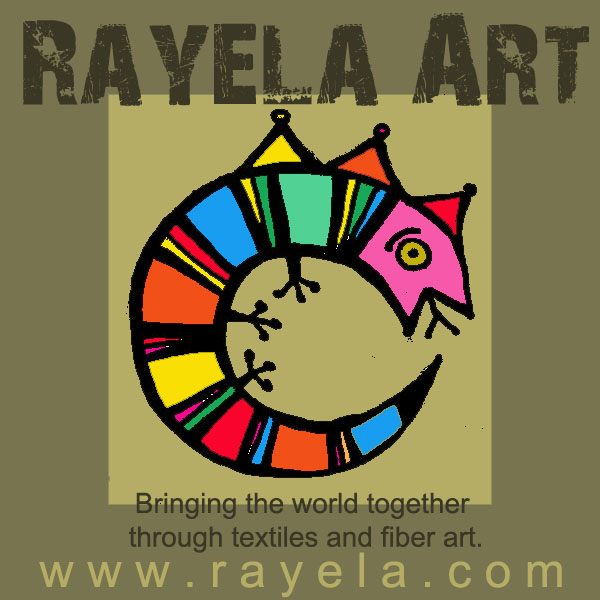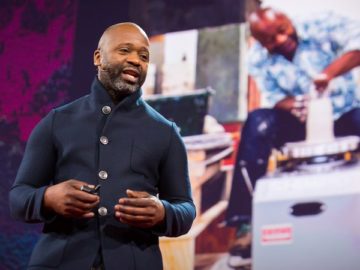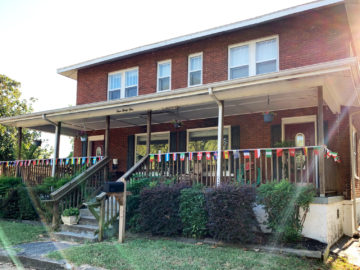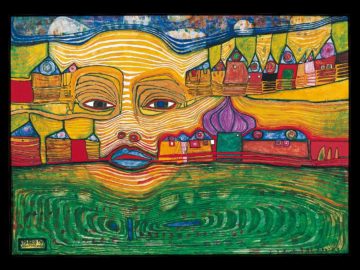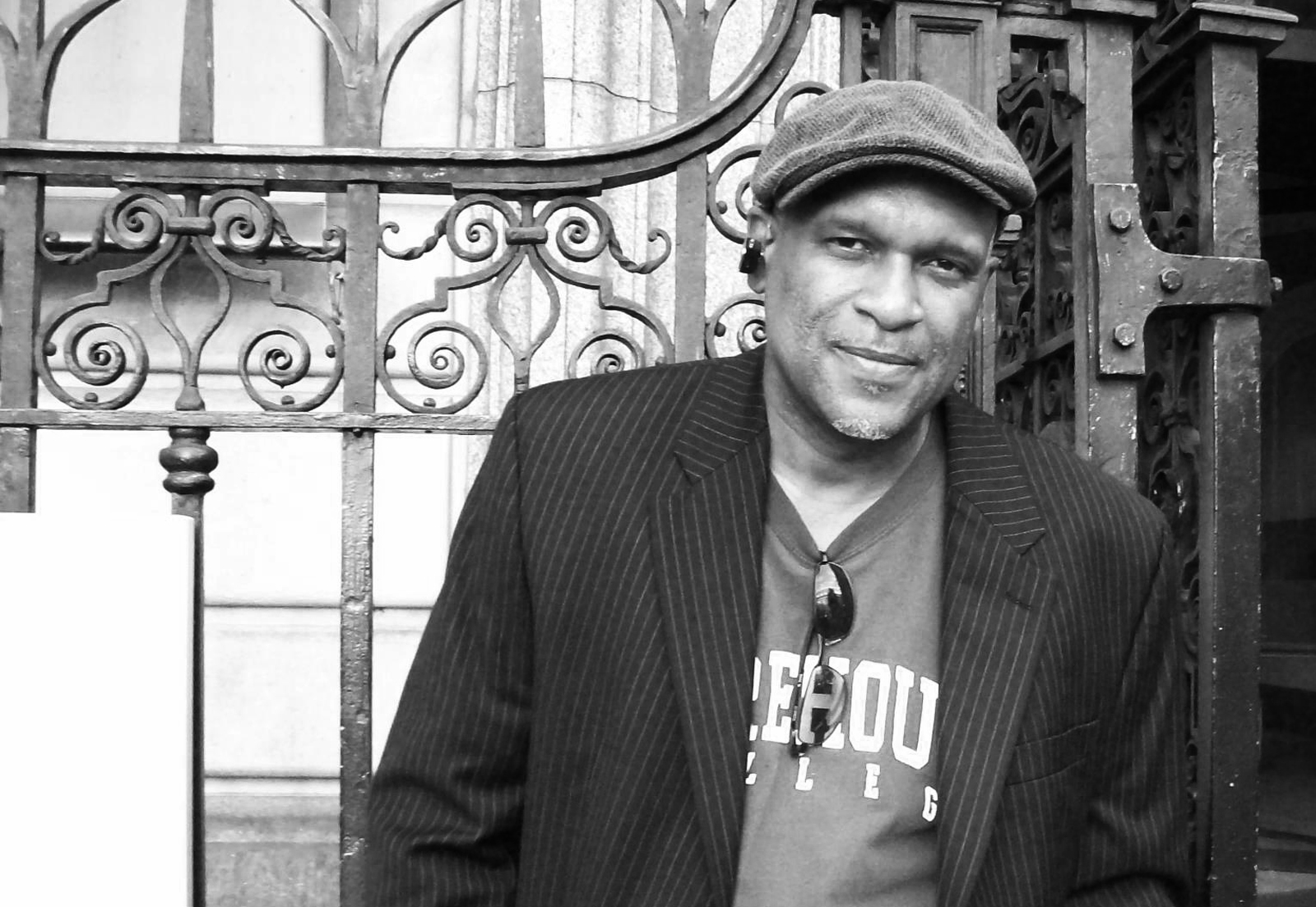
I want to tell you about my friend, John Zeigler from Chicago, and how he turned me on to the ABCD Institute’s approach to building community. ABCD stands for Asset Based Community Development and instead of looking at what a place and its people are lacking, you go at it from what they already have and how they can blossom.
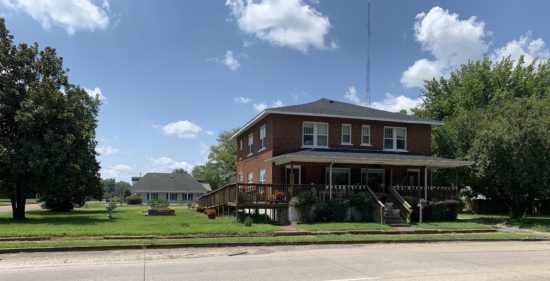
Green Roof International House, 2020
But, first, let me do a little recap: In 2019, I moved three times and ended up in a wonderful house in downtown Paducah, just a half a block away from City Hall and adjacent to the oldest Black neighborhood here. A friend of mine decided to become an angel investor in my ideas and purchased the property and has been a huge support. That Fall, I opened a brick and mortar shop for my online collective, Artizan Made, and while that was getting set up, my server destroyed both that site and my other online community, TAFA: The Textile and Fiber Art List. Ten years of work on one and six on the other just disappeared. I was too busy to focus on rebuilding the sites and went on to get the Airbnb going in the Green Roof International House, the property my friend bought. The second floor has three bedrooms that can be rented and the downstairs has a living room and dining room as communal space. By January of 2020, both the house and the shop were starting to stabilize. Then, Covid-19 hit in March and I had to shut everything down. In May one of my best friends was brutally murdered here which pulled the rug out from under me.
For three years, I had been working on ideas that could happen here around culture, creativity and sustainability. Past posts on this blog talk about these dreams, including how I could bring my two online communities into the mix and connect people here with creatives around the world. I still have not found my “tribe” here and was just starting to reach out to some of the local movers and shakers when all of this other stuff happened. I was unable to focus on anything and holed up for the rest of 2020, doing the best I could to get small tasks done. Now, I’ve had my first vaccine, the weather is warm and I feel bolder and ready to start moving forward on what was paused. I had talked to John about my ideas and used the winter months to read up on the ABCD approach and on Creative Placemaking, a similar approach but with a focus on the arts. My conversation with John made me rethink how I was “dreaming” and I realized that before anything could happen, some real work had to happen in understanding what is already happening here in Paducah and how my strengths and experiences could fit into the mix.
John Zeigler

John Zeigler is Director of the Egan Office of Urban Education and Community Partnerships (UECP) and adjunct faculty in Community Service Studies at DePaul University’s Steans Center.
Now, let me tell you a bit about John. We have been friends for almost 30 years now. Hard to believe! When we first met, I was running an artisan’s cooperative in Chicago. John is a beautiful man who has always been very comfortable with adornment. He has worn beads, necklaces, bracelets, dreds and hats with grace. He has always been a huge supporter of the arts and would just appear, chat for a while, laugh easily, and drop pearls of wisdom. I used to make artsy hats and he was my number one supporter.
Back then, he was working with teenagers in the most run-down neighborhoods of Chicago. He started a program with an International focus and went on several trips with these teens to Brazil and Africa. His drive was to expose them to the world, to enlarge their experiences and to challenge them to reach for the stars. At some point along the way, I also had a group of teens I was working with. I supervised an international summer program that hosted about 20 teens from Spain. I had them during the week and they stayed with family hosts on the weekends. What I hadn’t known was that these kids were coming from the wealthiest families of Barcelona. They had been everywhere, done everything and were utterly bored with whatever activities I came up with. Except for meeting with John. John brought some of his inner-city kids and I brought my Spanish kids for several hours at a park. They connected immediately, both groups fascinated by the other.
John has a gentle and calm demeanor, but also commands authority, something those kids picked up on right away. He is what they call a “connector”, someone who knows everybody and gets them to meet the people they need to meet. He is a story teller, an acute observer, and a lover of culture and of people. The ABCD Institute sure seems the perfect place for him!
John’s bio:
John Zeigler is Director of the Egan Office of Urban Education and Community Partnerships (UECP) and adjunct faculty in Community Service Studies at DePaul University’s Steans Center. He provides guidance in advancing DePaul faculty and student engagement with public agencies and community-based organizations and schools. Through innovative scholarship, technical assistance and educational programming in schools, UECP addresses critical social issues.
John has worked with numerous grassroots organizations and initiatives across the country helping to create change that speaks to the community’s values. He recognizes that the most effective solutions to community issues should be community-driven and believes in the power of building effective social networks and creating opportunities for community partners to share their practices, promising ideas and challenges. John is currently finishing his doctorate in education where his research interest is focused on authentic participation of black community-based organizations in the privatized environment of public schools.
The ABCD Approach
The basic message is to build from the bottom up. I think that most of us who have done community work know this intuitively, but end up tooting the wrong horn. We may see the needs, know of some things that might help, but because the process is not initiated nor owned by the community itself, it becomes imposed, forced, and will ultimately face defeat. It’s also a question of attitude, of having a colonial approach where the “helpers” are superior beings lending their resources and expertise to the inferiors.
Here’s some history from their site:
The Asset-Based Community Development Institute (ABCD) was co-founded by John L. McKnight, formerly the director of community studies at Northwestern University’s Institute for Policy Research, and his long-time collaborator in community research, John P. Kretzmann, a faculty member in the School of Education and Social Policy and IPR Faculty Associate at Northwestern. Challenging the traditional approach to solving urban problems, which focuses service providers and funding agencies on the needs and deficiencies of neighborhoods, Kretzmann and McKnight have demonstrated that community assets are key building blocks in sustainable urban and rural community revitalization efforts. These community assets include:
-
- the skills of local residents
- the power of local associations
- the resources of public, private and non-profit institutions
- the physical infrastructure and space in a community
- the economic resources and potential of local places
- the local history and culture of a neighborhood
Professor McKnight talks about how he was called to leave his community work in order to contribute to the academic one. Once he got there, he realized that all of the institutions engaged in addressing problems of poverty, racial inequality, nutrition, etc. were coming at the issues in an upside down way. They only saw the problems and how outsiders could come in and fix things. They did not see what gifts, passions, connections and problem-solving happened in these communities and how these assets could be strengthened. He decided to document how this happened and spent the next years traveling to different communities, finding out what their assets were and how the community itself might solve what they felt they needed.
McKnight’s ideas have spread throughout the world and the ABCD approach has shown great success over the years. Cormac Russell is one of the people who has helped grow this concept in Europe and other parts of the world. His bio on Nurture Development, the largest ABCD effort in Europe, states:
“Cormac is a social explorer, an author and a much sought after speaker. He is Managing Director of Nurture Development and a faculty member of the Asset-Based Community Development (ABCD) Institute, at DePaul University, Chicago.
Over the last 25 years, Cormac’s work has demonstrated an enduring impact in 35 countries around the world. He has trained communities, agencies, NGOs and governments in ABCD and other community-based approaches in Africa, Asia, Australia/Oceania, Europe and North America.”
Cormac delivered a moving TED talk in 2016 which really sums up this approach in a clear way:
Some of his zingers:
“Helping is a powerful and often beautiful impulse, but it has a shadow side. Certain styles or forms do more harm than good.”
“Rosabeth Moss Kanter said: When we do change to people, they experience it as violence; When people do change for themselves, they experience it as liberation.”
“To do no harm, start with what is strong, not with what is wrong.”
“By focusing on what is wrong, 4 things happen: people are defined by their problems and deficiencies, money which is intended to help people doesn’t get to them (it funds the staff and programming), the power to take action at the grassroots level retreats as technocracy takes over, and people internalize these approaches and end up believing that the only way that change will happen is if outsiders come in to save them.”
“By focusing on what is strong, a community can access that strength to create their own change. Community builders can help effect that change by identifying which resources can support that internal vision.”
“Lilla Watson (aborigine activist) said: If you’ve come to help me, you are wasting your time. But, if you’ve come because your liberation is bound up with mine, then let us work together.”
Cormac gave several examples of how things have happened in the communities he has worked with.
Creative Placemaking
The ABCD approach has happened in organically around the world since we started recording history. It really is about the age old bartering systems that have always been around, but with industrialization and the erosion of those informal community structures, the psychological consequences that McKnight and Cormac talk about have reduced people to despair and inaction. The creative community has often defied these obstacles by banding together, moving into distressed neighborhoods because of cheap rent, creating a vibrant place which then becomes hip, gentrifies and prices the artists out. I experienced this several times in my 20 years in Chicago. My first shop was in the Flat Iron Building in Wicker Park, 600 square feet, a building that served as an incubator for minority owned businesses, mostly artists. It was bought out by a developer and although it continued to house art related businesses, almost all of the original ones were forced out because our rents tripled.
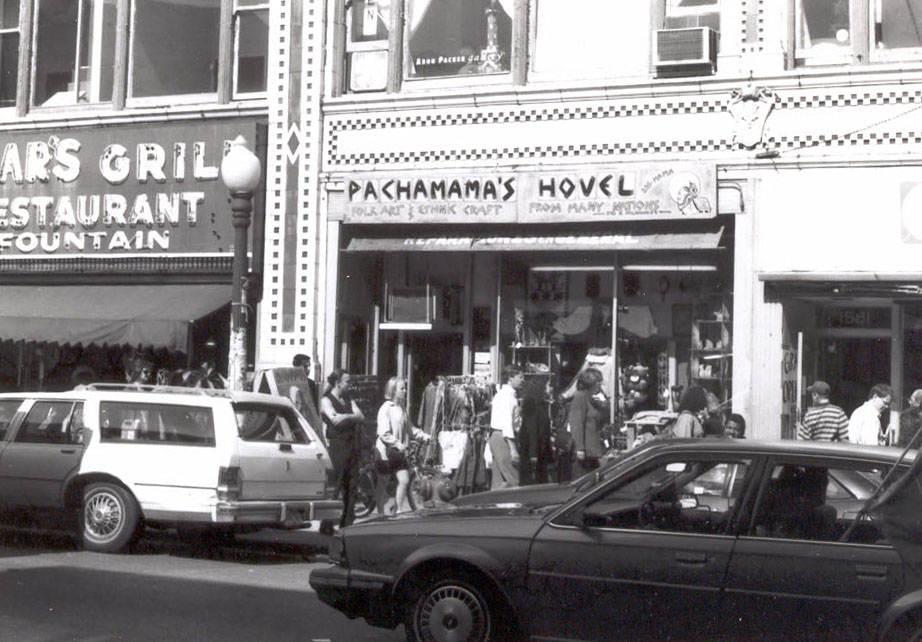
Pachamama’s Hovel, Flat Iron Building, Chicago, 1992
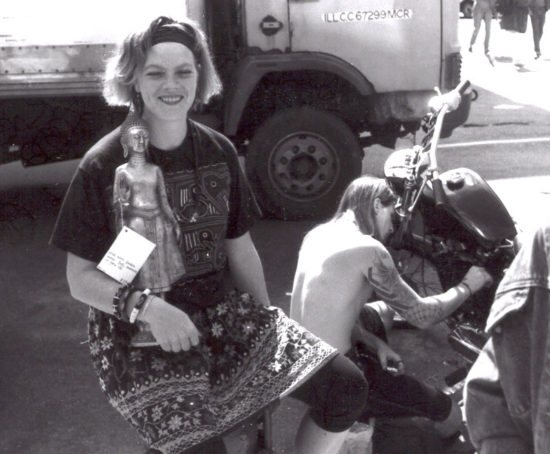
Me on the same day in 1993, when I was bright eyed and bushy tailed.
A hand painted sign… Something the City would outlaw in a few years. This neighborhood is now super trendy with outrageous rents.
The concept of Creative Placemaking was already a “thing” back then. Urban planners were recognizing that artists, restaurants, musicians, theater, etc. all brought people into neighborhoods and those people spent money.
I read a statistic before the pandemic hit that the creative economy in the US (including Hollywood and advertising) was much larger than the agricultural industry. I am sure that it is also the one that suffered the most in the last year. And, all along, creatives who shaped their own destinies without access to capital have been the least prized assets in our society. Compare how the sports industry is treated to the creative one.
Yet, as the industrial base in the US has eroded and the tech one has evolved into a monstrous demon, communities have thrived when art in all of its forms is made accessible to the people. Small towns and inner city neighborhoods all over the United States have been exploring this concept with mixed results. When the ABCD approach is used, building on the assets that are already there, the garden blooms. When outsiders come in and “develop” a creative community, a great deal of alienation can happen. I believe that this is the case, to some extent, here in Paducah.
Paducah Assets and Barriers
Paducah has a lot of great things going for it and much of it is already centered on the arts. It’s a destination for people in the region for indy movies, live performances, dining, architecture, galleries, and cultural events. There are exciting educational efforts happening for young people, both in high school and at our tech school. The hospitals have good reputations and there are a lot of good organizations and churches reaching out to people in need. Whatever you can’t buy locally, you can easily get online. I have found it a welcoming place to live with easy accessibility and plenty to do. We are “Quilt City USA” and listed as a UNESCO Creative City.
But, there is definitely a lot of need here with distressed neighborhoods, poverty and crime. Paducah made USA Today’s list of the poorest city in every state (2020):
Kentucky: Paducah
• Median household income: $35,419 (state: $48,392)
• Poverty rate: 22.3% (state: 17.9%)
• Median home value: $117,900 (state: $135,300)
• Population: 24,879
Paducah is a small city in western Kentucky located along the southern bank of the Ohio River. The typical Paducah household earns just $35,419 a year, well below the median income statewide of $48,392. Poverty is also more concentrated in Paducah than it is across the state as a whole. More than 22% of the local population lives below the poverty line, compared to about 18% of all Kentucky residents.
And, Money Inc listed it as the 12th Worst Place to live in Kentucky:
12. Paducah, Kentucky
Paducah has a population base of 24,879 residents. The unemployment rate is 5.3 percent with a median home value of $117,900, which are neither good, although not the worst by far. What makes Paducah the 12th worst place to live in the state is that the crime in the city is terribly high. The most recent FBI numbers indicate that 1 in 21.9 people who live in Paducah have a chance of becoming a property crime victim. The crime rate is the 5th worst in the state.
I was very involved with the Race Unity Group of Paducah until we stopped meeting due to covid. The two years of meetings showed me that the Black population here feels excluded from many of the cultural amenities in town and that good jobs tend to come around through a buddy system. Many of the churches here (Black and White) live in fear of a shooting and have security guards and lock their doors during services. There are over 400 teenagers who are “homeless” at any time, most couch surfing between houses. Only about 20% of the population has a higher education degree. Housing is expensive and there are not enough low income units for the need. The wealth that is here is not spent locally. It goes to vacation destinations or investments that don’t benefit locals. The list goes on and on.
I have been here since 2005 and see a nice, young, diverse group of leadership developing in Paducah. It has an active LGBTQ community which has shown solidarity with protests that took place last year around racial justice issues. It also has a core group of millennials who have started businesses and are putting down roots here, although the population overall has decreased steadily every year. So, there are good things happening along with big challenges. The main barriers for starting a project or trying to create an impact seem to be mistrust of outsiders and apathy. Still, several creative businesses have found support here and it’s been exciting to see the growth.
My Contribution
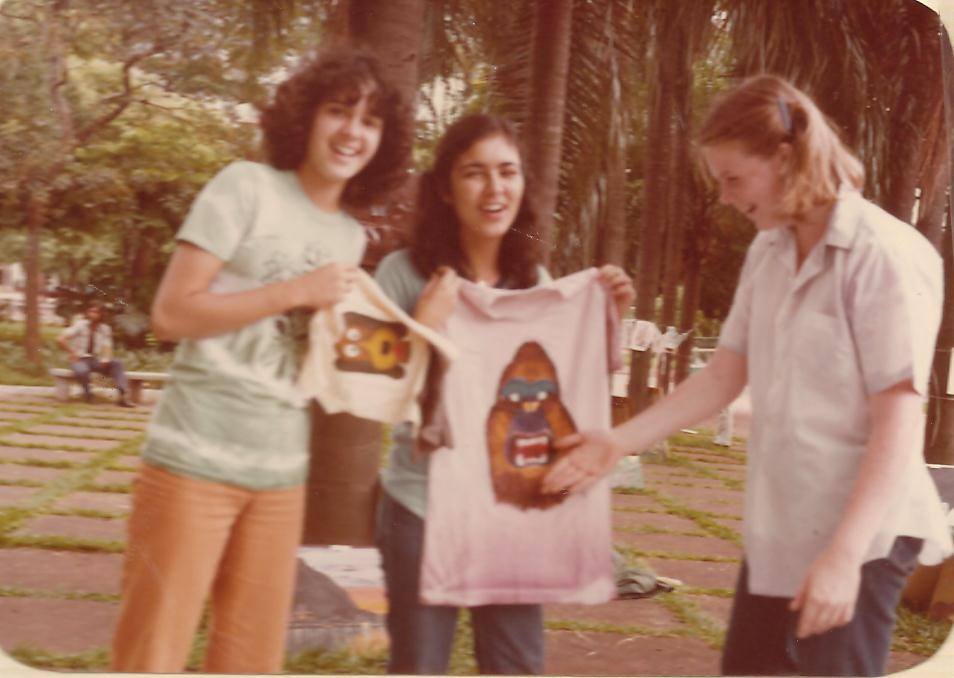
Selling T-shirts in Brazil, 1978, with Regina and Rose
In assessing my own strengths, weaknesses and passions, I have to go back to my roots and the marriage of my two big interests: making things and entrepreneurship. I started selling t-shirts that I painted at hippie fairs when I was 14, down in Brazil. From then on, I have always had this desire to be part artist, part merchant. I’ve worked with the handmade community for almost 30 years now, have long term relationships with fair trade groups, sold on Etsy and eBay for years and would like to pass on that knowledge to people here and to create jobs manufacturing goods out of garbage. One thing every poor community has is plenty of raw material with the waste we generate. And, again, in learning about the ABCD model, I recognize what so many groups have done all around the world with ideas, passion and some materials. One of my favorite examples:
I am especially interested in products we can make with glass (which is not recycled here). My expertise lies in textiles and I also worked with clay for three years, so it will be fun to see what emerges over time. Artizan Made, the collective I run, can serve as an incubator for new entrepreneurs, just like I did as a young business person so many years ago at the Flat Iron Building in Chicago… What comes around CAN go around!
Other people will have their own ideas, talents, and strengths. This group will hopefully shine a light on all kinds of actions that are already happening or can happen if we just water the soil. It’s exciting!
Change is in the Air
Covid-19 has been a time of loss for so many of us, but Biden’s Build Back Better initiative could become a time of revival for this country. There will be a lot of money flowing towards community projects, especially for minorities, poverty alleviation, employment and boosting businesses that have been damaged by the pandemic. The Creative Placemaking movement already has the backing of foundations and funders looking to invest in new ideas. The ABCD model can help us evaluate how Paducah can grow and thrive from what is already here. We just need to be able to identify and elevate all of those resources that seem so disconnected at this time. I see a real need for publicizing our services and talent along with welcoming those who are currently marginalized and left out of the conversation.
John and his team are available to us as guides in this process and I propose that we start a study group to form an ABCD Paducah chapter. There are several workbooks (I ordered three) and loads of resources available online. I can host meetings at Green Roof and we can meet in other places as the group solidifies.
Resources:
There are loads of videos on YouTube and orgs working with these models, but here are a couple of good places to start:
- ABCD Institute: https://resources.depaul.edu/abcd-institute/Pages/default.aspx
- National Endowment for the Arts (their creative placemaking resources): https://www.arts.gov/impact/creative-placemaking/creative-placemaking-resources
- The National Consortium for Creative Placemaking: https://www.cpcommunities.org/
Will you join me?
We will have an informational meeting once the word gets out about this and then decide on a structure.
Please feel free to leave comments with questions and observations. If you are not local, consider looking at how the ABCD model could work in your community!
